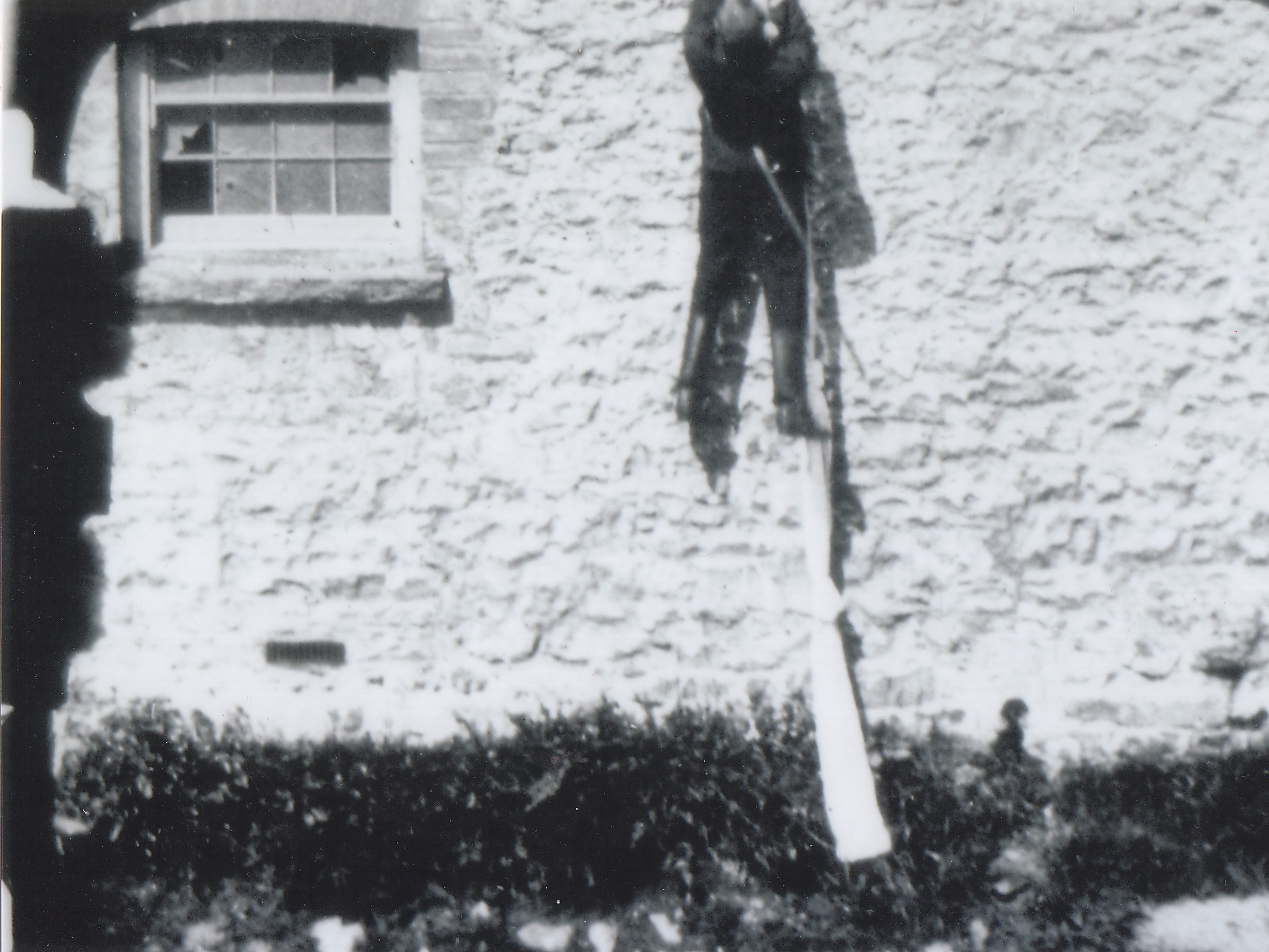William
Haggar, Fairground Film-Maker
The Extant Films
Original copies of the extant films are held at the British Film
Institute.
Viewing copies are held at the National Screen and Sound Archive of
Wales.
Thanks are due to the National Screen and Sound Archive of
Wales for the still photographs of William Haggar's films.
National Screen and Sound Archive of
Wales retain copyright over these images.
1. Outside the Works / Haggar's Bioscope Camera (1902 / 3)
A scrap of film, lasting only 45 seconds, was given to the Welsh
Screen
and Sound Archive in 1998. After lengthy conservation, it turns out to
be a "local film" of the type taken by Mitchell & Kenyon and many
others, showing workmen outside a large Works, so far unidentified. The
scene changes to another street, and there is William Haggar, smiling
broadly, and holding a large board on which are the words "Hagggar's
Bioscope Camera". Clearly he was taken in the act of encouraging the
workmen to bring their friends and relations to see themselves in the
Bioscope show.
Picture: Workmen outside the works
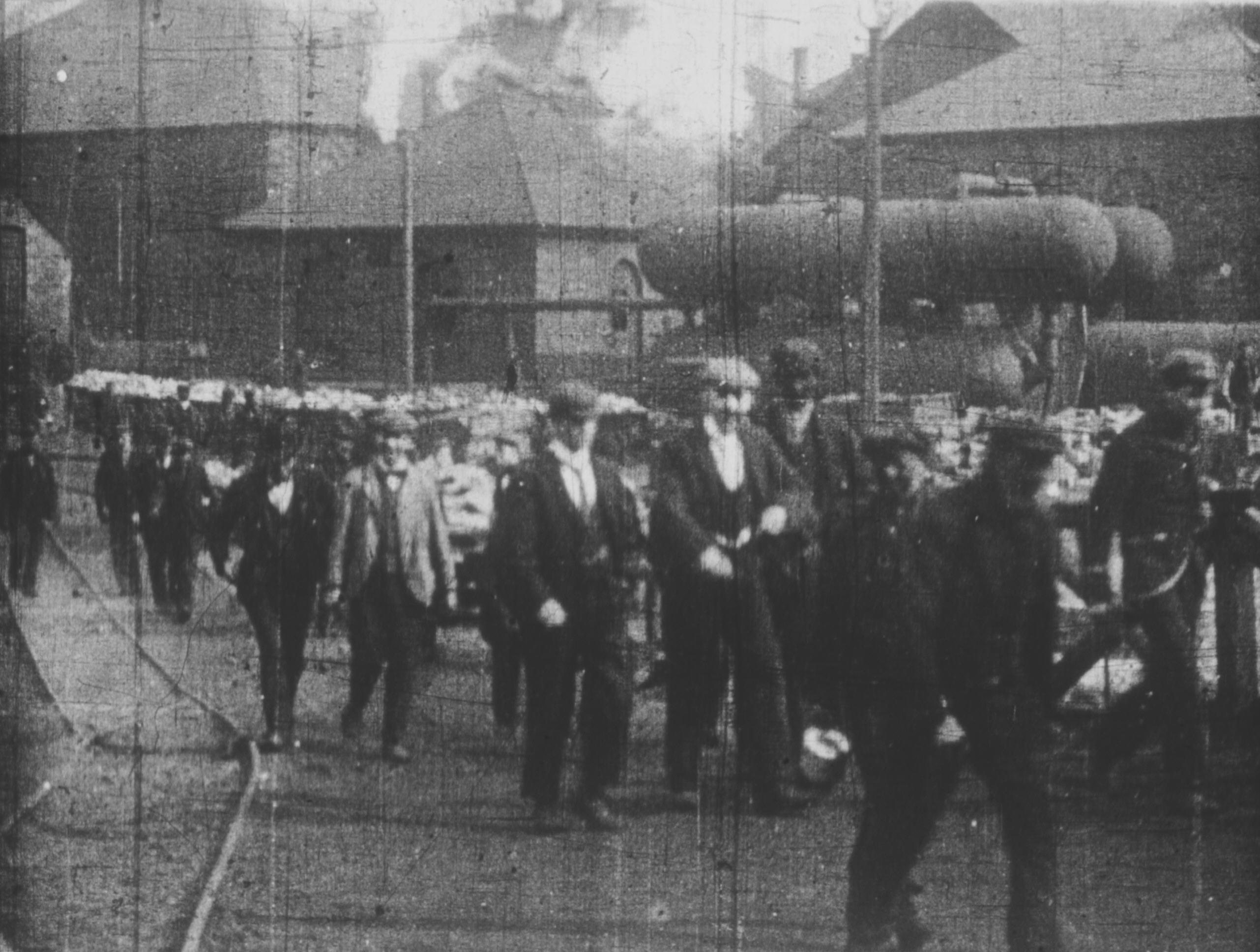
2. Desperate Poaching Affray (aka The Poachers) - 1903
In the days before hiring out, this film sold 480 copies, more
than any
other on record. It was made, according to Walter Haggar who appears in
it, in one afternoon, with some dogs, a live rabbit, and a coconut-shy
net, and lasts three minutes. Two poachers, played by Will Haggar
Junior and Sid Griffiths, are surprised and chased by gamekeepers.
Police, passers-by and dogs join in the chase. Shots are fired. The
chase leads through two fords, everyone getting a wetting. Eventually
the miscreants are captured and led off dejectedly past the camera.
Sold in the USA, according to film historians, it helped set the
pattern for subsequnt Hollywood chases.
Picture: The Poachers caught at the ford
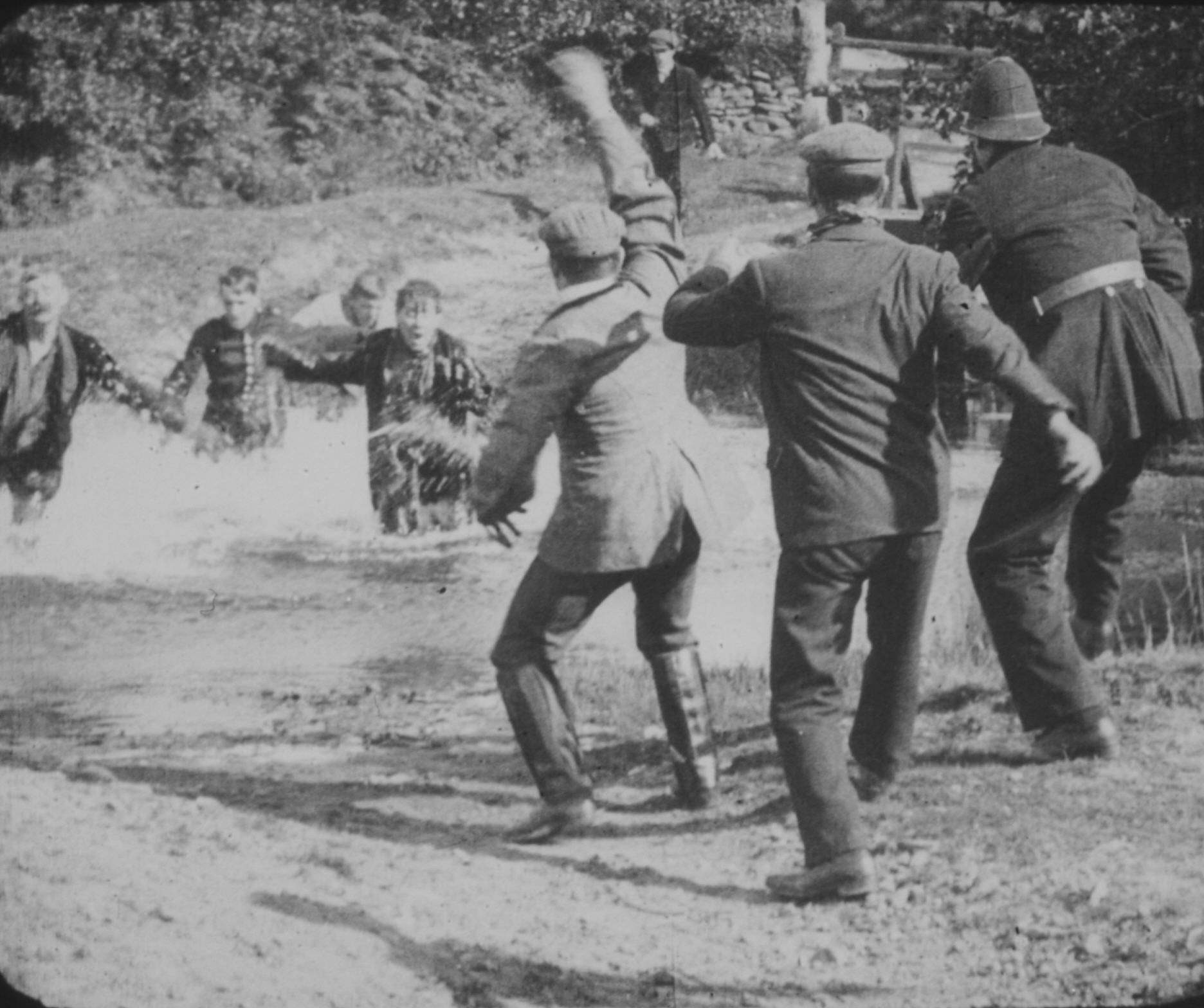
3. The Bathers' Revenge - 1904
One of a series of short comedies, the film lasts just one minute.
Young people are enjoying a swim, leaving their clothes on a waterside
seat. A courting couple occupy the seat, casting aside the clothes. In
revenge, the bathers tie a rope to the seat, and pull it and the couple
into the water. Walter Haggar plays the "girl" in drag.
Picture: The couple on the seat
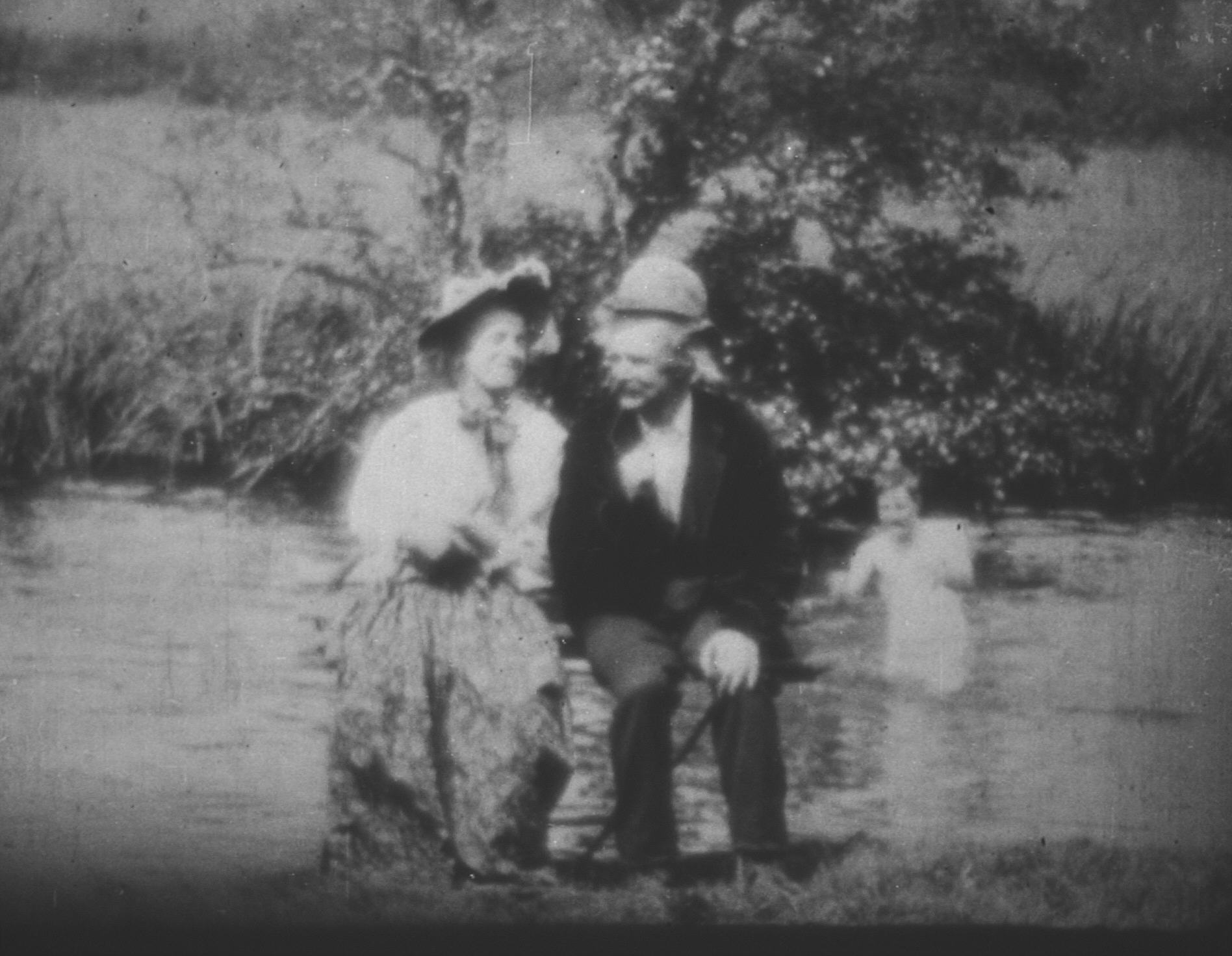
4. The Life of Charles Peace - 1905
Haggar's most famous film tells, in 10 minutes and 11 scenes, the
story
of the Victorian burglar and murderer Charles Peace, played by Walter
Haggar, with his mother, his brothers Fred, Jim, Henry, and his
sisters Violet and Lily also in the cast. The film combines the genres
of drama and chase, and William, using intertitles for perhaps the
first time, deploys innovative camera positioning and cutting within
scenes. Peace is shown burgling, then ogling Mrs Dyson, and shooting
her husband. At home, he is chased round the roof by police, but
escapes.
Caught in the act of another burglary, he flees, is pursued, and
eventually captured. While being taken back for trial, he throws
himself from a railway carriage window (perhaps the first use of a
dummy on film), but is recaptured, identified by Mrs. Dyson, and led to
the scaffold. We see him drop. Walter later claimed that this execution
scene was done for real, and that he was nearly throttled.
Picture: Peace shoots Dyson as Mrs Dyson looks on 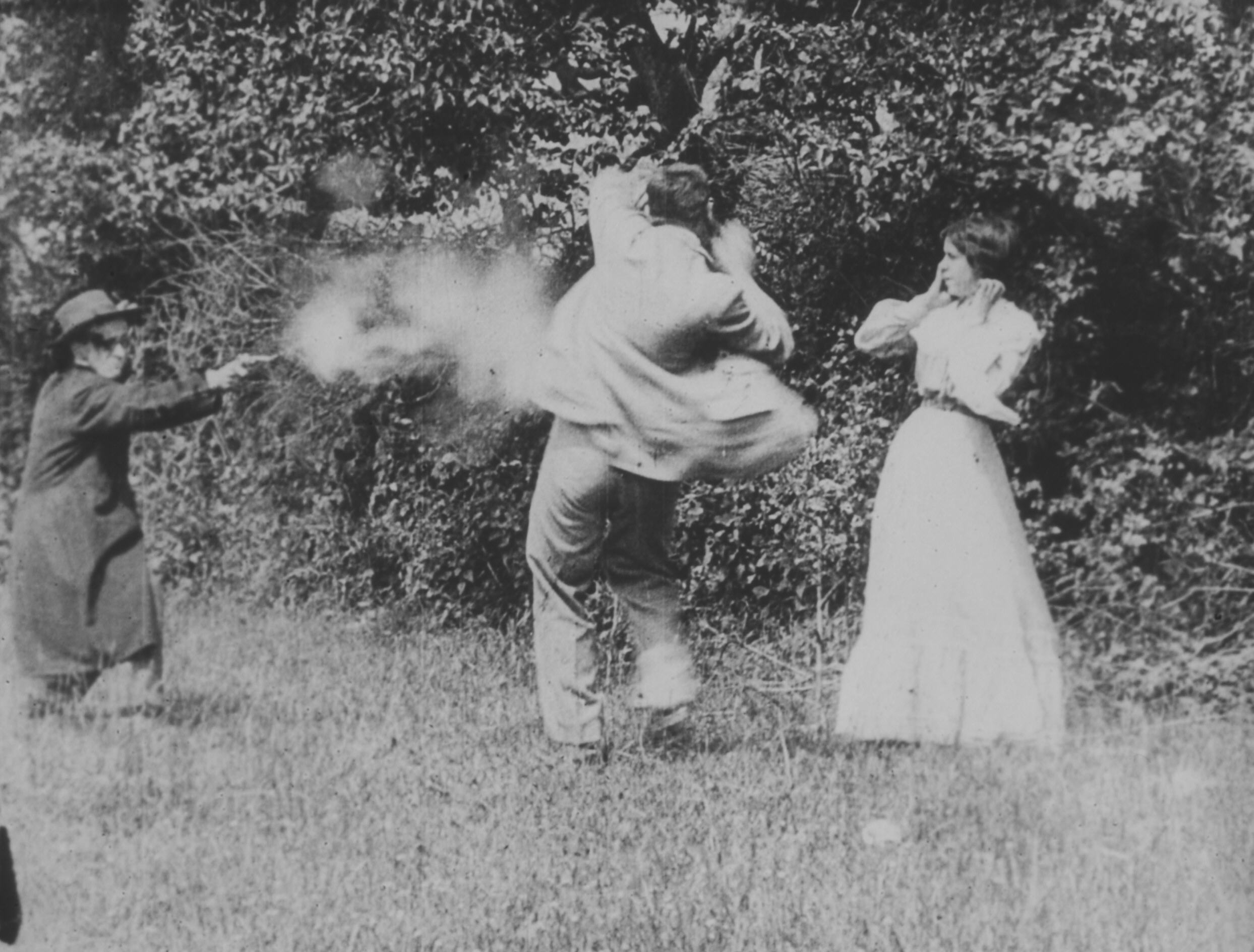
5. A Message from the Sea - 1905
Only the first scene of this melodrama survives. It shows the
hero,
Harry Mainstay, played by Will Haggar Junior, bidding goodbye to his
wife and child, as he goes off to sea. The plot continued with Harry,
shipwrecked and on a raft, casting a bottle with a despairing message
into the sea. Washed ashore, the bottle was found by his wife, who
assumed he was lost. But no! he had been picked up at the last gasp,
and, in a happy ending, returned to find his wife tending his memorial.
Walter later told how, when the film was made at Burry Port sands, the
raft kept getting stuck on a sandbank, and the hero had to move it
while standing waist deep in the "ocean".
Picture: Harry Mainstay departs on a voyage
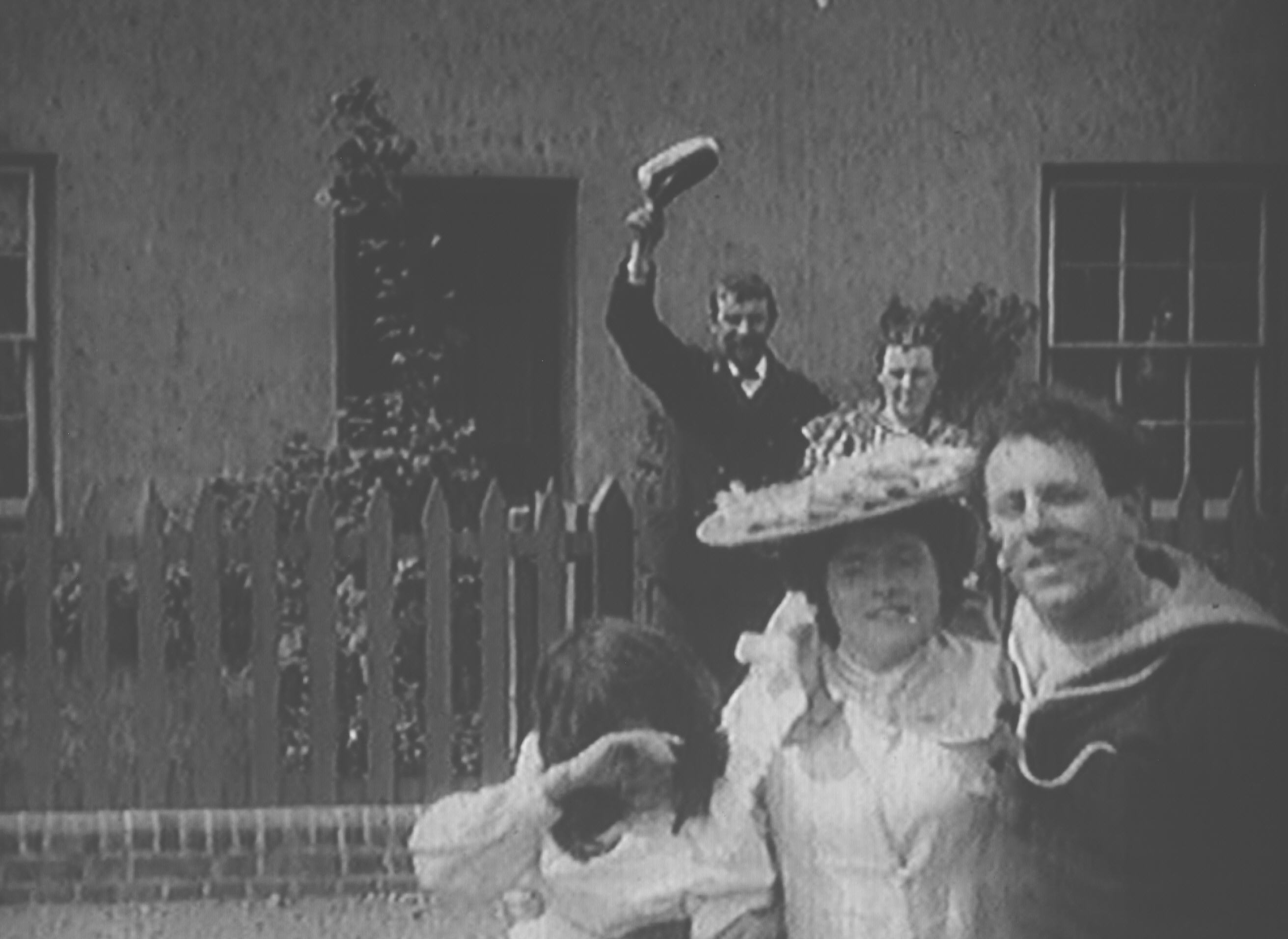
6. The Sheep Stealer - 1908
Lasting eight minutes and featuring Jim Haggar, his wife Kate and
children Lily and Jim Junior, this extended chase film begins in the
Sheep Stealer's cottage: his cupboard is bare. Begging from a farmer in
vain, he steals a sheep, and rushes off with it. It is a large and
heavy sheep, and it struggles: he lets it go, and is caught, but
escapes. The resultant chase by the farmer, his shepherd, police,
passers-by and dogs, leads up hill, down dale, across a weir, and
eventually back home again. He sinks, exhausted and cornered: but the
farmer, pitying his starving wife and children, forgives him, giving
money to the children while the husband and wife embrace.
Picture: Sheep Stealing
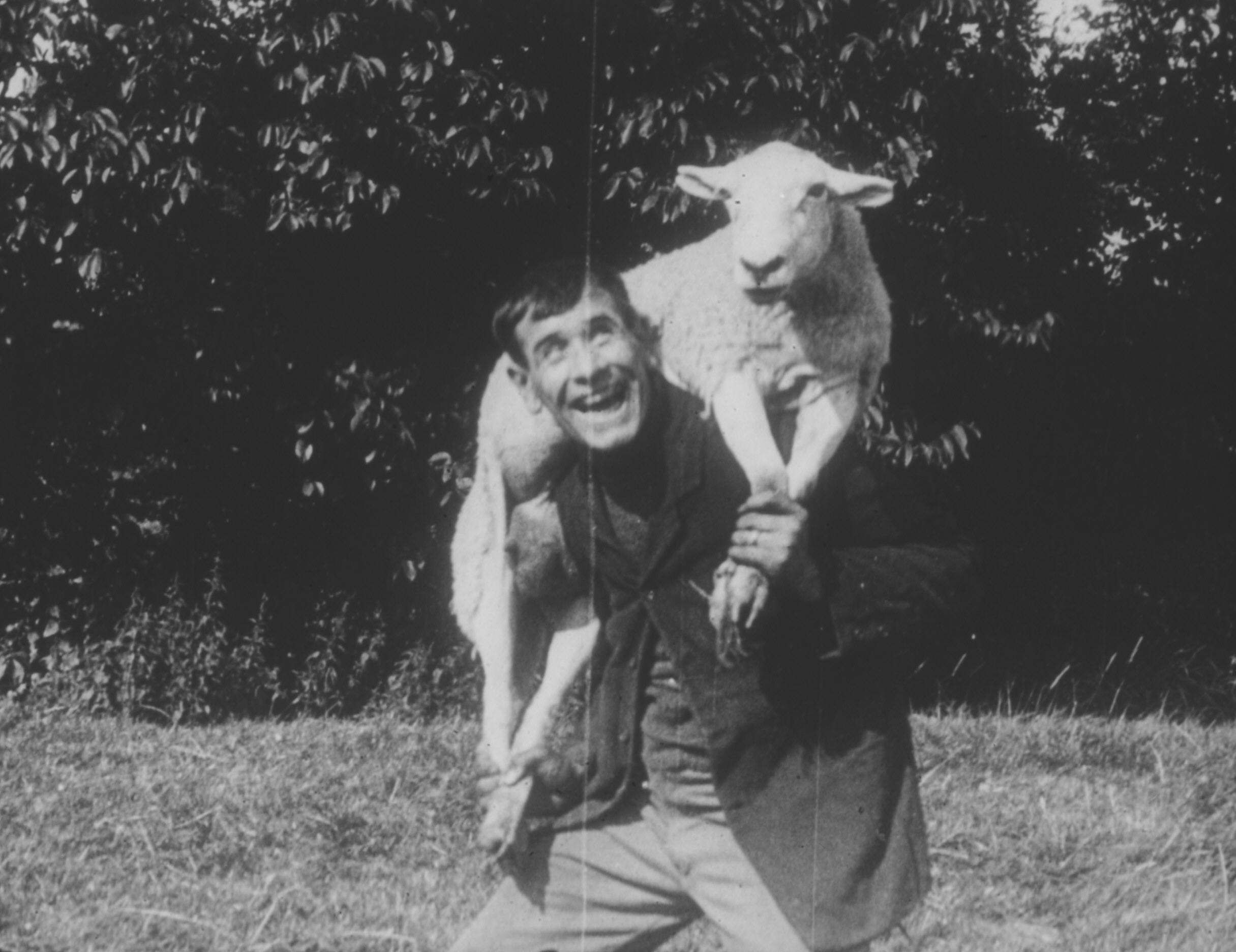
7. The Stepney Wedding - 1911
This is a "newsreel" shot by William and Jim Haggar of a society
wedding in Llanelli. We see the wedding processions entering and
leaving the church, shot from various angles. At the end of the film,
one cameraman shoots the other: the second time William can be seen on
film.
Picture: The bridal procession enters the church
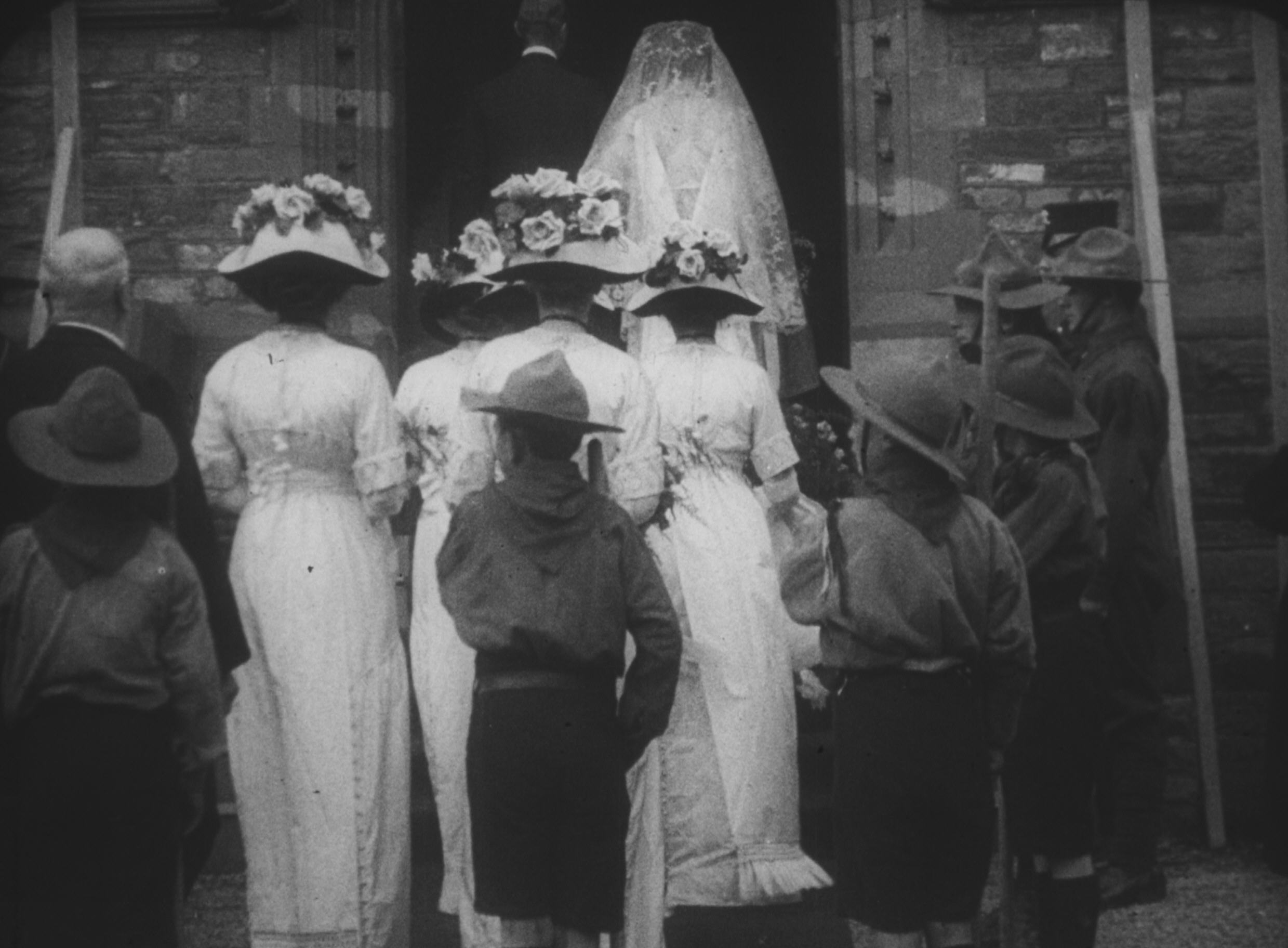
8. The Maid of Cefn Ydfa - 1914
The first film of this Welsh drama had, in 1902, made the Haggar's
fortune. After a longer remake in 1908, Will Junior decided to produce
a much longer version,
starring himself and his wife, the actress Jenny Lindon, with members
of his theatrical company. Hiring a London cameraman, he produced a
series of static, far distant sequences, which horrified his father,
who insisted on re-shooting many scenes, and spent hours editing them
into what was worth saving from Will's first attempt. The result was an
uneven masterpiece: lasting 50 minutes, it showed Will's Edwardian
theatre company playing its party piece, in silence, but modified by
the greater opportunities permitted by film. First shown in Aberdare on
14 December 1914, it was last shown, and favourably reviewed in Cardiff
in 1938. Rediscovered in a family cupboard under the stairs in 1984, it
was conserved: 38 minutes survives. Sub-titled "The Love Story of Ann
Thomas", the film portrays Ann, the Maid, an heiress, falling in love
with a thatcher, Will Hopkins. However, Ann's mother schemes to get her
hands on Ann's estate by forcing Ann to marry her creature, Anthony
Maddox, a drunken lawyer. Ann is duped into believing that Will has
deserted her, Will arriving at the church just too late to prevent the
wedding. He goes abroad, Ann enduring a loveless marriage and a dead
baby. At that point, the film fails: the ending would have involved
Will's return and Ann's death in his arms. The tragedy is relieved by a
Shakespeare-style sub-plot involving Lewis Bach, a faithful retainer,
played by Will Fyffe, the future music hall and film star, at this time
learning his art with the Haggars.
Picture: Will and Ann fall in love
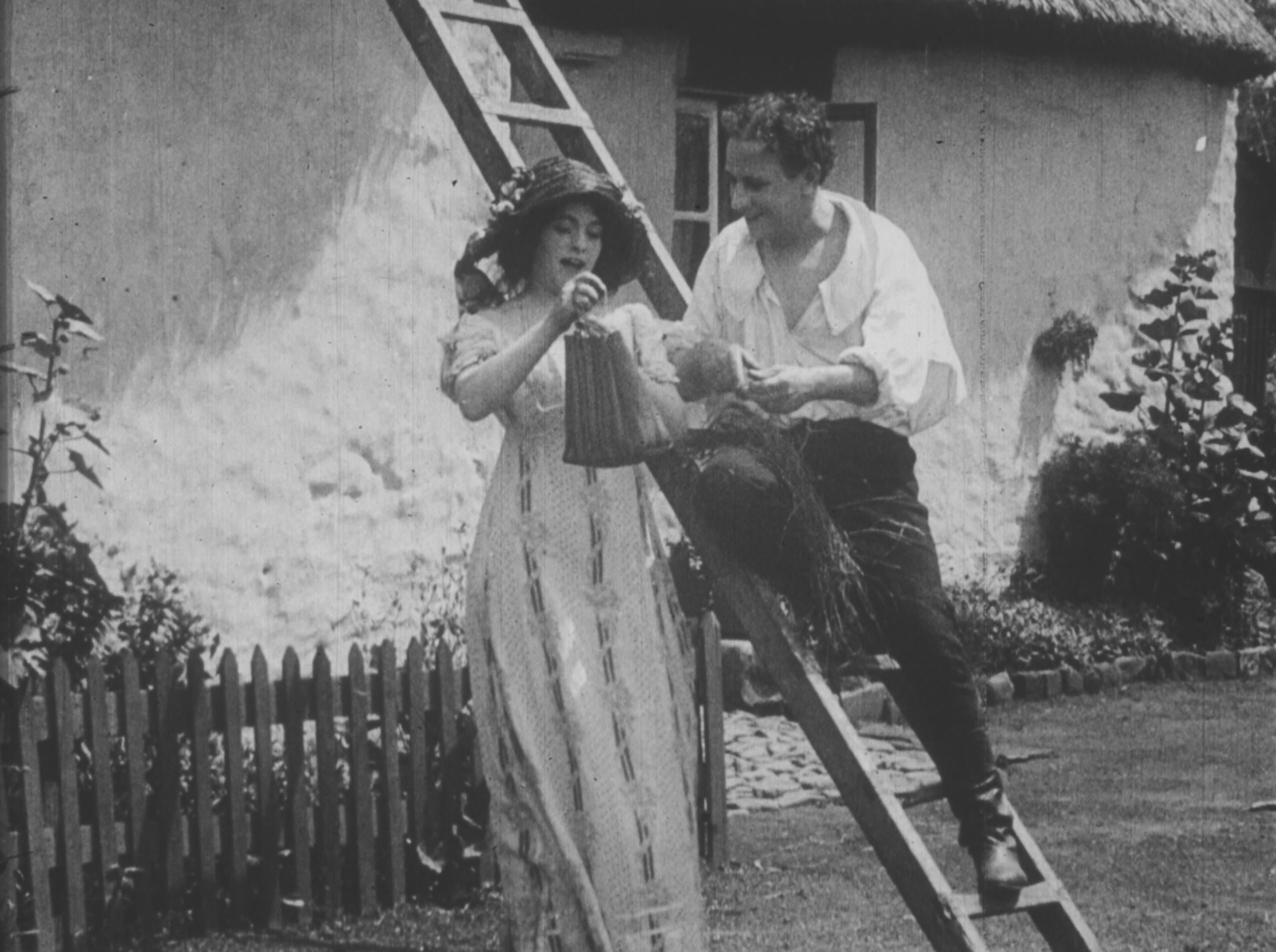
9. The Plumber and the Lunatics - 1908
Not positively identified as by William, this film has many
stylistic similarities and might be his. It is another three-minute
chase film: a plumber, called to do repairs at an Asylum, drops his
knife. Two inmates pick it up and gesticulate with it. The plumber
backs off and runs away, pursued by the pair and the Superintendent of
the asylum. They hurdle the pens of an empty cattle-market, and burst
through road works. In the end, the plumber gives in, but the pair
merely return him the knife with a fulsome salute. "All that fuss just
to give a fellow a knife!" is the closing title.
10. Revenge! - 1904
This "new" Haggar film has recently been discovered in the US Library
of Congress, where a copy was deposited to claim copyright when it was on sale
there in 1904. Its dramatic chase sequences, sex and violence will have delighted
its fairground audiences. The hero, played by Will Haggar Junior, has been
unjustly confined in an Asylum by the Master of the Asylum, so that he can seduce
the hero's wife. Will Junior escapes down a rope of knotted sheets (pictured), and
surprises the Master embracing his wife, but in the ensuing melee the wife and his
little daughter are both shot dead, and he is recaptured. Again he escapes, and flees
along a stream. Brought to bay at the edge of a precipice, he whirls four warders to
their deaths, then returns to the Asylum to settle his score: the film, 7 minutes
long, ends with him strangling the Master with his bare hands.
Picture: Escape from the Asylum
